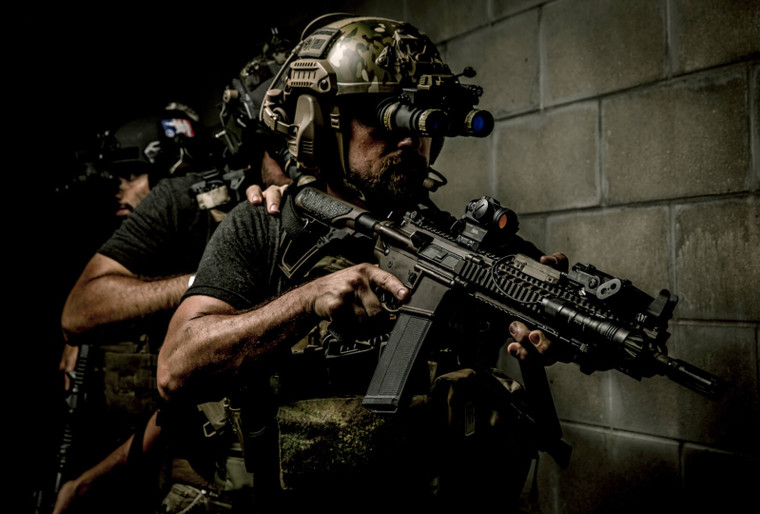An Intro to Night Vision
Aug 4th 2021
How to choose and use your night vision kit.
When it comes to night vision gear, it’s possible to spend a fortune and get a lot of junk. The truth about night vision kit is that you’re usually going to get what you pay for, and if you want reliable, high-performance gear then you can’t afford to skimp and buy the knock-offs.
As my friend and night vision aficionado, Sam Houston, says: “Good night vision isn’t cheap, and cheap night vision isn’t good.”
And I can attest from many nights kicking in doors with the Ranger battalion, quality night vision gear gives you a significant life or death advantage in tactical situations.
Here are a few considerations Sam and I compiled as you prepare to invest in this kind of advanced gear for personal defense.
Set Reasonable Expectations and Budget
While it’s probably not necessary for your purposes to drop $20K on night vision kit (which is entirely possible), you do want to keep in mind that good gear is going to come with a fairly stout price tag. So you really need to have a realistic expectation and budget when you start shopping.
For a single goggle set up, you should expect to spend between $4,500 and $5,500 if you want the functionality you’re expecting when you gear up for dark-time activity. And of course this set up isn’t just the goggle itself. This also includes the two other essentials–the mount and the helmet–which ensure you can operate hands free. Otherwise what’s the point.
For a double goggle set up, expect to spend double that. (That probably doesn’t require a lot of explanation.)
Single vs Double Night Vision
There are advantages and disadvantages to both the single and double goggle night vision setup.
Single Goggle. Single is, of course, half the cost, but it’s not necessarily half the benefit. There’s also potential tactical advantages to the one eye approach. The greatest benefit I’ve experienced is that the non-enhanced eye allows you to see the surroundings the way the enemy sees and to experience their limitations.
Regarding disadvantages to this approach, good training can diminish most of those.
Double Goggle. While your field of view doesn’t change much between single and double, the double does give you what Sam refers to as a greater “perceived spatial awareness.” Because both eyes are seeing the same thing, your brain isn’t having to work as hard to process the information coming in. I’ve found that the perceived improvement to spatial awareness does potentially reduce mental fatigue, especially during hours-long use.
With the right training, of course, you can become super efficient and effective with either setup.
White Phosphor vs Green
Green is not accomplishing anything less than white phosphor in terms of visibility, but white phosphor does reduce eye fatigue and provide a bit cleaner, more natural light. This is why the military is transitioning away from green and toward white phosphor for most night vision applications.
PVS-14 vs PVS-7
Don’t waste your time or money with PVS-7, a technology that was replaced by PVS-14 more than two decades ago. The PVS-14 is the Glock 19 of night vision. That’s where you want to invest your money for logistical support, warranty, accessories that interface with it, etc.
Reputable Sources for Night Vision Gear
If you’re buying new from a reputable dealer, you’re likely going to be safe in terms of quality, warranty, etc. If you’re shopping around and maybe attempting to buy used, be aware of age, blemishes, maintenance and wear and tear. You can hit a home run and knock it out of the park and get something really cool. Or you can get taken for all you’re worth. You just need to be careful when sourcing used stuff.
Night Vision Training
To become tactically proficient with operating at night, good training is an invaluable resource. As with firearms and other proficiencies, in a tactical situation your trained instincts are your best friend.
To learn more about the firearms and tactics training we offer, visit us here.
As always–Train Hard. Train Smart.

